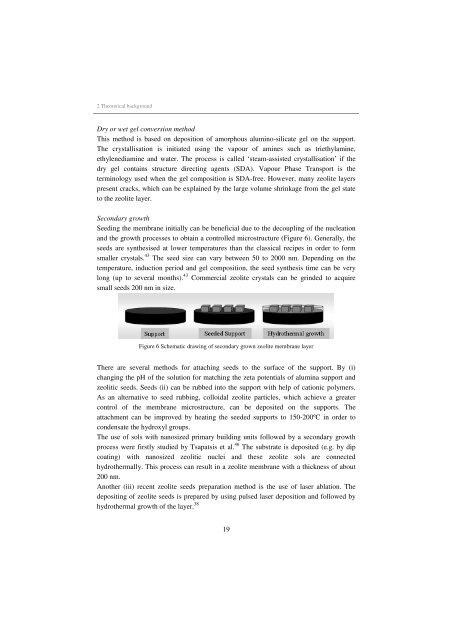Inorganic Microporous Membranes for Gas Separation in Fossil Fuel ...
Inorganic Microporous Membranes for Gas Separation in Fossil Fuel ...
Inorganic Microporous Membranes for Gas Separation in Fossil Fuel ...
Create successful ePaper yourself
Turn your PDF publications into a flip-book with our unique Google optimized e-Paper software.
2 Theoretical background<br />
Dry or wet gel conversion method<br />
This method is based on deposition of amorphous alum<strong>in</strong>o-silicate gel on the support.<br />
The crystallisation is <strong>in</strong>itiated us<strong>in</strong>g the vapour of am<strong>in</strong>es such as triethylam<strong>in</strong>e,<br />
ethylenediam<strong>in</strong>e and water. The process is called ‘steam-assisted crystallisation’ if the<br />
dry gel conta<strong>in</strong>s structure direct<strong>in</strong>g agents (SDA). Vapour Phase Transport is the<br />
term<strong>in</strong>ology used when the gel composition is SDA-free. However, many zeolite layers<br />
present cracks, which can be expla<strong>in</strong>ed by the large volume shr<strong>in</strong>kage from the gel state<br />
to the zeolite layer.<br />
Secondary growth<br />
Seed<strong>in</strong>g the membrane <strong>in</strong>itially can be beneficial due to the decoupl<strong>in</strong>g of the nucleation<br />
and the growth processes to obta<strong>in</strong> a controlled microstructure (Figure 6). Generally, the<br />
seeds are synthesised at lower temperatures than the classical recipes <strong>in</strong> order to <strong>for</strong>m<br />
smaller crystals. 43 The seed size can vary between 50 to 2000 nm. Depend<strong>in</strong>g on the<br />
temperature, <strong>in</strong>duction period and gel composition, the seed synthesis time can be very<br />
long (up to several months). 43 Commercial zeolite crystals can be gr<strong>in</strong>ded to acquire<br />
small seeds 200 nm <strong>in</strong> size.<br />
Figure 6 Schematic draw<strong>in</strong>g of secondary grown zeolite membrane layer<br />
There are several methods <strong>for</strong> attach<strong>in</strong>g seeds to the surface of the support. By (i)<br />
chang<strong>in</strong>g the pH of the solution <strong>for</strong> match<strong>in</strong>g the zeta potentials of alum<strong>in</strong>a support and<br />
zeolitic seeds. Seeds (ii) can be rubbed <strong>in</strong>to the support with help of cationic polymers.<br />
As an alternative to seed rubb<strong>in</strong>g, colloidal zeolite particles, which achieve a greater<br />
control of the membrane microstructure, can be deposited on the supports. The<br />
attachment can be improved by heat<strong>in</strong>g the seeded supports to 150-200ºC <strong>in</strong> order to<br />
condensate the hydroxyl groups.<br />
The use of sols with nanosized primary build<strong>in</strong>g units followed by a secondary growth<br />
process were firstly studied by Tsapatsis et al. 46 The substrate is deposited (e.g. by dip<br />
coat<strong>in</strong>g) with nanosized zeolitic nuclei and these zeolite sols are connected<br />
hydrothermally. This process can result <strong>in</strong> a zeolite membrane with a thickness of about<br />
200 nm.<br />
Another (iii) recent zeolite seeds preparation method is the use of laser ablation. The<br />
deposit<strong>in</strong>g of zeolite seeds is prepared by us<strong>in</strong>g pulsed laser deposition and followed by<br />
hydrothermal growth of the layer. 38<br />
19

















